This is an in-depth review of the Vulcan Absolute Power Bar; the black oxide and raw steel variant (the other variant being entirely stainless steel). While the two Absolute Power Bar variants are similar they are also very different, so this review is not quite as relevant when it comes to the SS Absolute.
The Absolute Power Bar is a relatively new addition to the Vulcan bar line-up. It’s a rather beautiful, high strength, IPF-spec’d bar that has all of the features that you’d expect from a premium powerlifting bar; like a strong, 29 mm shaft; black oxide finish over a moderately-aggressive knurl; grooved bare steel sleeves; and a 4″ passive center knurl. The Absolute has a couple of unique features as well.
The two notable and unique features of the Absolute consist of a much higher than average tensile strength shaft than other power bars (which I’ll talk about more below), and a classy, laser-engraved Vulcan USA logo on the inside of the sleeve collars. The laser engraving is only a cosmetic feature of course, but it does give the Absolute a classy look.
Last Update: January 2018 – minor edits and corrections.
Absolute Power Bar Specifications
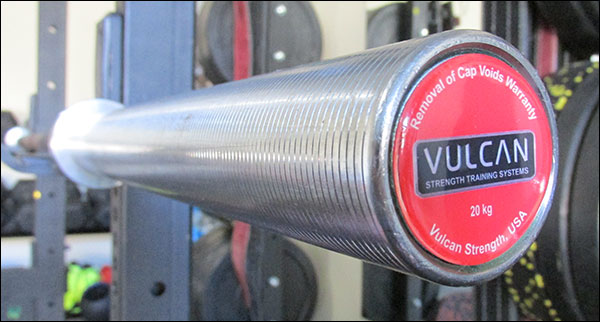
Here is a rundown on the Absolute’s specs that you can refer to while reading this review, or when making comparisons to other bars. You can also find most of this information on the product page for the Absolute here.
- IPF standard men’s 20 kg bar, 2200 mm in length
- IPF power marks with 4″ center knurl
- Shaft diameter: 29 mm
- Shaft finish: black oxide
- Tensile strength: 221,000 PSI
- Sleeve finish: none (bare steel)
- Loadable sleeve length: 16¼”
- Knurling: moderately aggressive
- Rotation: bushing system
- Warranty: standard limited lifetime
- Price: $339 (includes shipping)
I want to draw special attention to the fact that the Absolute is a black oxide and bare steel power bar. While this is a very standard set-up for a power bar (black oxide + aggressive knurl makes for a great grip), I still like to remind folks that both bare steel and black oxide require maintenance. Without frequent oilings, this bar will definitely rust. Keep that WD-40 or 3-in-1 oil on-hand.
If this upkeep is bothersome to you and you have some extra money to spend, consider the totally stainless steel variant of the Absolute Power Bar. It is not only corrosion-resistant, it also has the strongest tensile strength shaft of any stainless steel power bar in existence. It sells for $549.
Absolute Review – Shaft
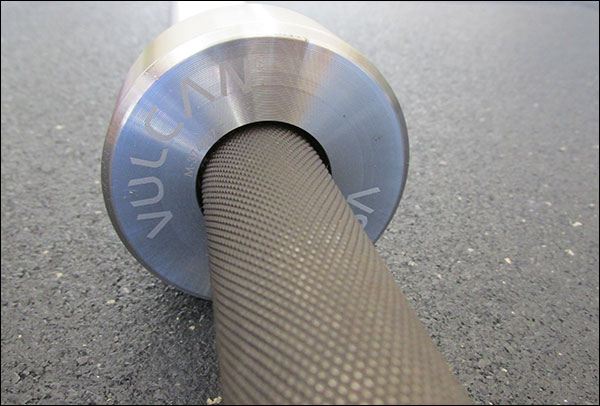
At 221,000 PSI, the Vulcan Absolute is currently the strongest and one of the stiffest power bars on the market. No other power bar in this price range even comes close. *
* edit: this is no longer true, though it’s still higher than most – and it’s much less expensive than those with higher tensile strength.
To give you an idea of what is considered normal for a power bar, the Texas Power Bar is rated at about 186k PSI, all of the American Barbell power bars are rated at 190k PSI, and the Rogue Ohio variants and the Westside power bars are all rated at 205k PSI. You can get a 215k PSI power bar if you’re willing to spend $849 on the Performance Power Bar, but I can’t make a good case for why you would need to do that.
Don’t get me wrong, I’m not saying that tensile strength is the be-all, end-all of bar specs, but it is an important factor with power bars. Strong, rigid shafts are less likely to flex and whip at heavier loads, and when it comes to the bench press, squat, and most accessory barbell movements, whip is not needed nor is it desired.
Absolute Review – Sleeve Rotation
The sleeves of the Absolute Power Bar spin on bushings, and the spin is minimal at best. The sleeves do spin, of course, but they do not spin excessively or as freely as you would expect of say a CrossFit or Olympic weightlifting bar.
If this were any other kind of bar I’d worry that the spin was insufficient, but for powerlifting this is pretty great. Plus, based on personal experience with half a dozen other Vulcan bars, I can only assume these tighter sleeves were an intentional move to eliminate erratic spin during the slower, heavier, big-3 lifts.
In other words, the slower sleeves are a perk in this case.
Absolute Review – Knurling
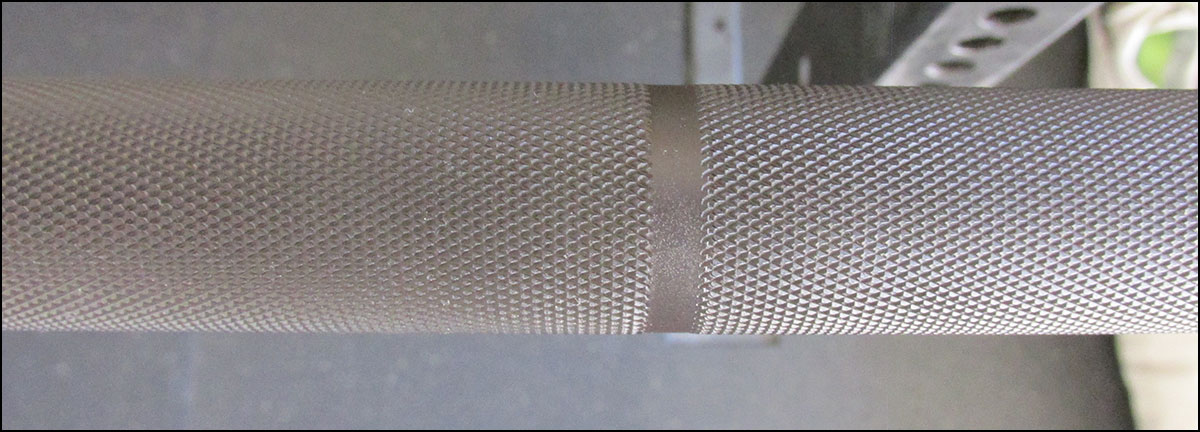
The knurling is what makes the Absolute one of my favorite new bars. The knurl pattern is moderately aggressive, but without being uncomfortable or overly sharp. I would say that it has just a hint less bite than the Ohio or Texas power bars, but not by enough to weaken the security of the grip.
As most of you already know, black oxide combined with a good knurl makes for a fantastic grip. Matter of fact, I’ve been favoring the Absolute to my American Barbell Super Power Bar lately, which is quite the compliment to the Vulcan considering both the stainless steel shaft and nearly $600 price tag of the Super.
To summarize though, I consider the knurl of the Absolute to be aggressive, just not quite super aggressive. Knurling is completely subjective, I realize this, but it’s really damn good knurl as far as I’m concerned.
Absolute Review – Elasticity
As you would expect of a 29 mm power bar with a 200,000+ PSI rating, the Absolute has pretty much no elasticity at all to it. Matter of fact, to say that the Absolute is stiff and rigid is quite the understatement. When the bar is sitting in the rack loaded for squats or bench press, it takes over 400-pounds before the Absolute even begins to display any noticeable flex. Put 400+ pounds on your WOD bar and it starts to look like a bow.
Absolute Power Bar Review – Finish
As already mentioned, the Absolute’s 29 mm steel shaft is treated with a black oxide finish. Black oxide is simply a conversion coating that offers mild corrosion/oxidation resistance while at the same time improving the appearance of the steel. Black oxide is favorable to black zinc for barbells because it doesn’t diminish the quality and feel of the knurling like zinc (and chrome) finishes do. However the downside to black oxide versus other finishes is that it can and will still rust if not maintained (oiled and cleaned.)
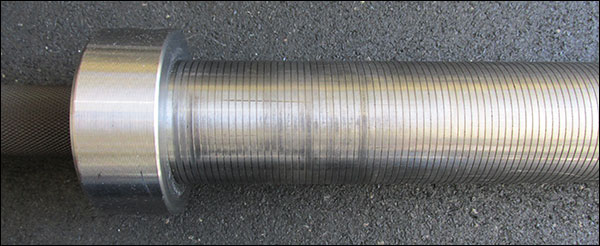
The sleeves of the Absolute have no finish whatsoever; they are raw steel. Believe it or not, because of how seldom your hands and body will come in contact with bar sleeves, even raw sleeves are easier to keep rust-free than a black oxide shaft. The image above is my Absolute, and although you can see markings from loading discs, there is no rust present. I have cleaned rust off of the shaft of my Absolute at least a half a dozen times, but not once have I had to remove rust from the sleeves.
Cleaning and oiling can be a pain in the ass sometimes, and there is something to be said for chrome finished bars that don’t require this kind of maintenance and upkeep, but if a natural, secure feeling is important to you when you’re moving the big weights, you either need to get used to having to oil your bar from time to time, or bust out the big bucks for some stainless steel.
Absolute Power Bar vs Ohio Power Bar
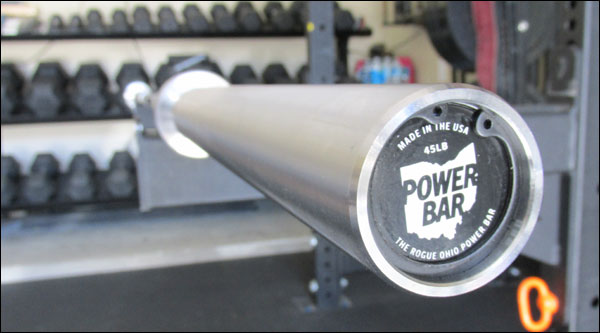
There is no denying that the bare steel Ohio Power Bar is a steal for the price. $250 plus shipping for a super rigid, 205,000 PSI power bar is a great deal, and the knurl on the Ohio is definitely top-notch. It’s a great power bar, and that $250 price tag works out to be about $60 less than the Absolute to your door.
So what’s different between the Ohio Power and Absolute Power? The Ohio will start to flex at lower weights. It’s not a dramatic difference, but the stronger you are the more this may matter to you. Also the sleeves of the Ohio Power spin almost as well as an Oly bar, which would be great if it wasn’t a power bar. Finally, the black oxide shaft of the Absolute is a bit easier to maintain and keep rust-free than the bare steel Ohio, though there is a zinc Ohio Power Bar for only $25 more.
So the question is if I had neither bar but had to buy one, which would it be? That’s a tough call! If budget wasn’t an issue, definitely the Absolute. If budget was an issue, I’d be happy to save the $60 and train with the Ohio Power. At the end of the day, both are great values, and both are more than enough bar for pretty much all big-3 lifters.
Absolute Power Bar vs American Barbell Power Bars
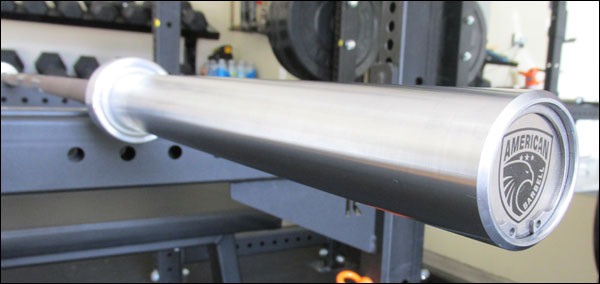
American Barbell currently offers two different power bars; the basic AB Power Bar for $295 and the stainless steel Elite Power Bar for $450. Both of these AB power bars are nice, well refined pieces of equipment – they look great, they’re durable, and they have rust-resistant finishes. However, performance-wise, the Vulcan Absolute just shames the AB power bars.
American Barbell power bars have overly soft knurl, and the shafts are only rated at 190k PSI – a rating more appropriate for a WOD bar than a power bar. Couple the soft knurl and average steel with the higher price of AB’s bars and there is just little justification to buying an AB power bar save for the low-maintenance finishes (which, don’t get me wrong, is a nice perk.)
I find that in the powerlifting world, raw steel and black oxide is not only acceptable, but also preferred to the oxidation-resistant finishes like zinc and chrome. This fact makes the chrome-finished American Barbell power bar less appealing since it comes at the cost of knurl quality; or overall grip security. Of course the stainless steel Elite does offer a more secure, natural grip despite the weaker knurl, but the $450 price tag is off-putting to most folks.
Absolute Power Bar vs Vulcan Elite Power Bar
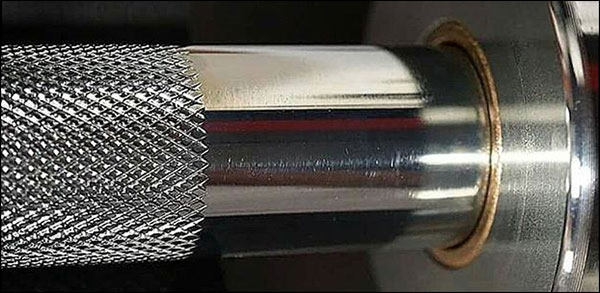
The Vulcan Elite Power Bar is an interesting power bar. It’s one of the only power bars with a bright zinc finish – no chrome, no oxide, no bare steel. It’s a super rigid, 196,000 PSI bar. Not quite as high as the Absolute or the Ohio, but still somehow stiff as a board even when loaded to the hilt.
The Elite is odd in that it has dual markings, but that doesn’t really change the performance of the bar one way or another. The knurl is much the same between the two, but when it comes down to it, for only a $30 difference between the Elite and Absolute I have to favor the Absolute. The exception would be for people who live in extremely humid regions and are willing to forego a little tensile strength for a oxidation-resistant, zinc finish.
Absolute Power Bar vs the Texas Power Bar
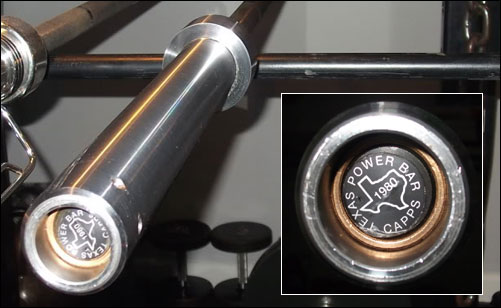
Ah the classic Texas Power Bar. This is another alternative to the Absolute that you may be considering. Tried and true, the TPB is much like the Absolute in that it has a black shaft and raw steel sleeves. The knurl of the TPB is super aggressive, and the shaft is up there in terms of rigidity.
Save for the pinned sleeves I have no issues with the Texas Power Bar. It’s known to hold a lot of weight, stay straight, and stay together. You do have to make damn sure you buy an authentic Buddy Capps TPB if you’re going to buy one though, so keep that in mind if this bar is on your list.
Vulcan Absolute Power Bar Review Summary
I dig the Vulcan Absolute – it’s a top tier power bar at a reasonable price. No, it’s not your only good power bar option, but it is one of the better options – at least in my opinion. All of the specs are great, it isn’t missing anything, and it doesn’t have anything that it shouldn’t have. It’s a solid power bar, and it’s been my go-to bar ever since I got it; replacing some very good and expensive bars. Check it out here.
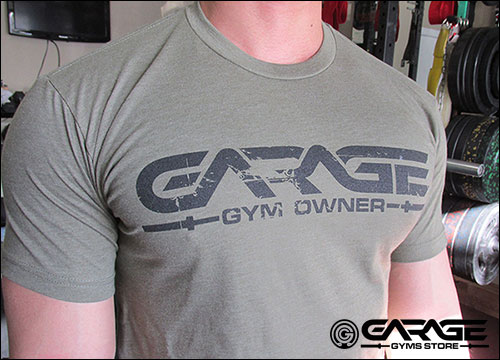

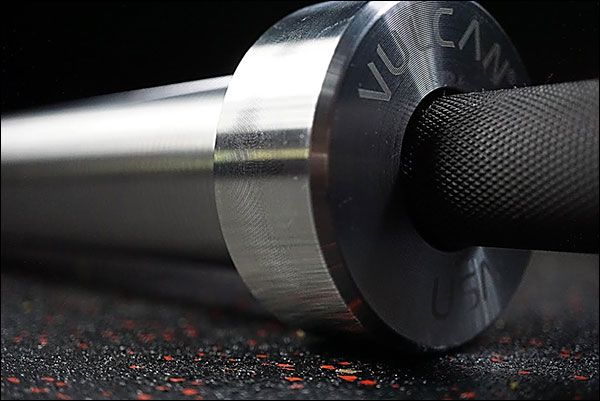
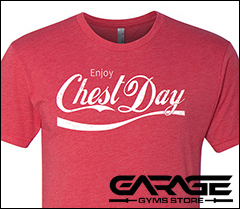
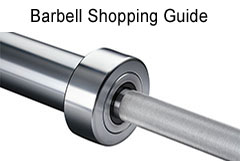
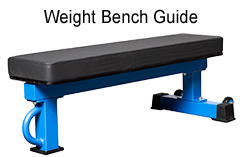
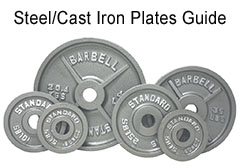
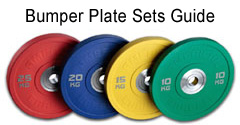
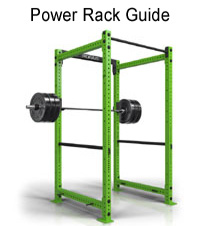
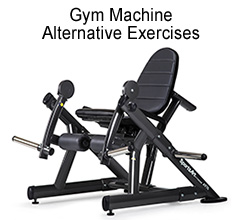

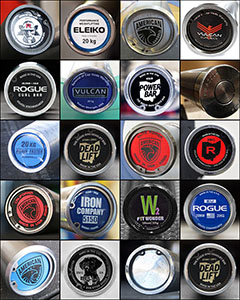

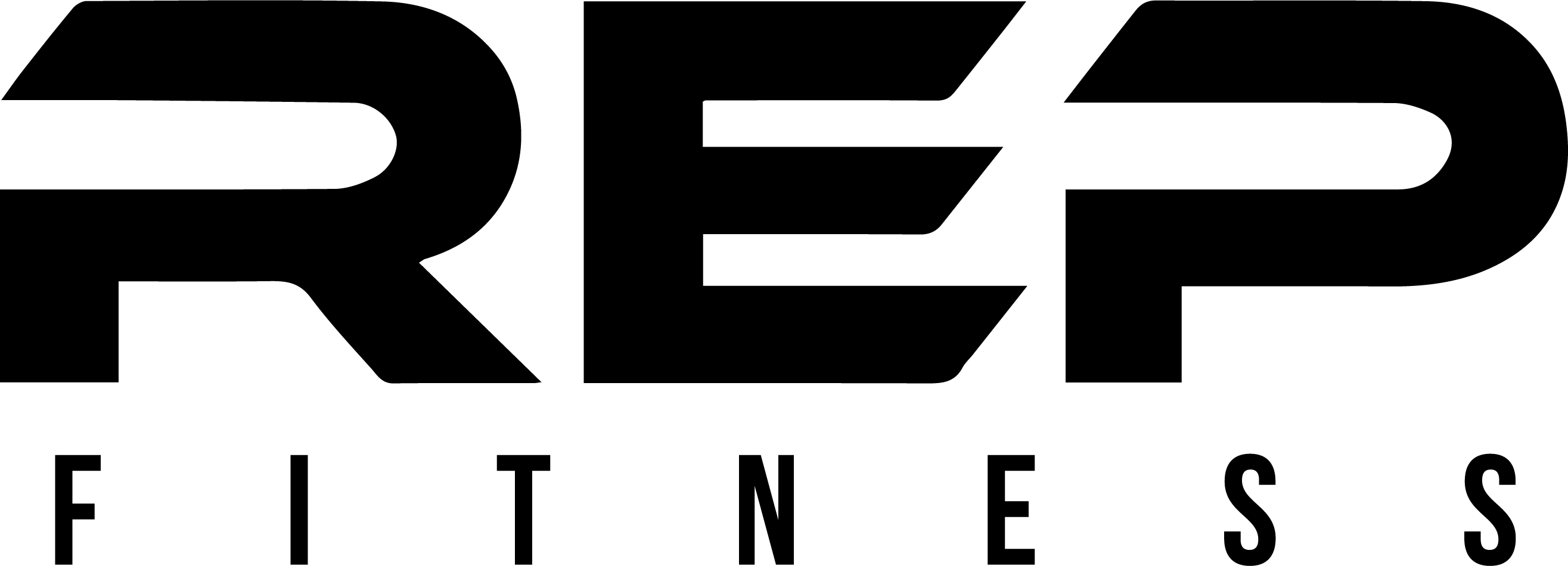
Solid review. I especially appreciate how you match the Absolute up against specific bars.
I use a B&R 1.0 bar that Rogue clearanced about 6 months ago. I’m curious how the Absolute’s knurl matches the B&R. Mine has good grip with bare skin but seems super-secure once I use chalk.
Thanks Robert. The original B&R has great knurl – substantial and secure – but it’s not as aggressive as the Absolute. Still, I wouldn’t go out of my way to replace the B&R if there isn’t anything wrong with it.
I’ve been wanting a Vulcan bar for a while now, and this one may be it. I’m planning on picking up one of their Slim Fit rigs and may pick up one of these at the same time to round out my arsenal. However, I know I’m terrible about cleaning bars. My AB SS and Eleiko bars look great with minimal oxidation that cleans up pretty easily save for a few spots, and I hardly ever clean them.
How often are you brushing and oiling this one? Also, do you actually use the wire brush Eleiko provides for those bars? My regular scrub brush can’t really get down into the knurling, but I’m scared to death that wire brush is going to destroy the chrome.
By the way, have you ever come across one of Vulcan’s flat benches? Wondering how their 3×3 version might compare to my Rogue utility bench (2.0 version).
I have only brushed it with a nylon brush once, but I oil it at least once a week. I don’t tend to use my wire brushes on anything but raw steel, but I have carefully used wire on both zinc and chrome in the past without taking off the finish.
I have not used the Vulcan bench, but I sure don’t see anything wrong with it it.
I am going to wait for a possible ‘b-side’ Absolute. I purchased an ‘event’ Elite and it was flawless. Or, I’ll wait and see what Vulcan is having for B. Friday. I have gone way over budget this past year with bars. I have been wanting this bar since it came out.
Looks like Rogue will be releasing SS Ohio bars soon. Wonder if they might release a SS Ohio power bar.
I’m glad you included the bits about the Vulcan elite power bar and rogue bar! Really helped me bite the bullet on the elite power bar. I also ordered their 3×3 bench, my max is over 400 so I’ll let you know how I like it.
Yeah I was eyeing that bench… I dunno where I’d put another bench though! I’d be curious to hear how it is.
J:
Did you see that AB now has the Cerakote Mammoth Bar (IPF spec, 210,000 psi, 29mm) on sale for $450 until Nov 30?
Have you had any feedback about the Mammoth; specifically the knurling/feel?
I know that Cerakote is far more corrosion resistant than 416 SS, but I’m not sure why it would be necessary, since a barbell is not exposed to the extreme conditions that some firearms are.
I’ve seen it on the site, but it’s only been available for a few days so I’ve not gotten even a hint of feedback. Also btw the reviews there on the product page are leftovers from the Super Power Bar and not for the Mammoth (I don’t think that was the right way to go about that. They should have made a new product page since it’s a completely different bar.)
My initial opinion is that finishing stainless steel is redundant no matter what you finish it with. Neither the stainless nor the Cerakote will oxidize unless; like you said; it’s subjected to some pretty extreme conditions. Why not finish a normal alloy steel shaft with the Cerakote and charge us $100-$200 less? Why bother using stainless just to cover it up?
I’m on the fence. I’m sure it’s just as nice as any other AB bar, but it’s a bushing-based power bar. It doesn’t have an expensive, high-whip shaft, it has no bearings, and the fact that it’s stainless has been negated by the finish. Seems way, way too expensive. We’ll see what people say though, and if you are at all interested in it I’d definitely get it now while it’s at least only $450.
J:
I just got off the phone with AB Customer Service. Basically, the Mammoth is the same steel as the old Super Power Bar (210k psi; heat treated) reworked to IPF spec with bar diameter increased from 28.5 mm to 29 mm.
My thinking was that the Cerakote might actually enhance grip (depending on the color and ratio of hardener to base). However, at least in firearms applications, Cerakote is applied much thicker than Black Oxide (typically .01905 mm vs .00003 mm); similar to the thickness of Hard Chrome, but more grippy. Anyway, AB, after extensive testing, feels that this is the case. I’m skeptical.
Also, the knurling is a bit more aggressive than the Olympic SS Bearing and SS Precision Training bars. In other words, the same as the SPB, as you described.
I agree with you. Bare steel is the gold standard for bar feel and SS will not corrode in a gym setting. Better to treat a carbon steel bar with Cerakote for a finish superior to even hard chrome.
There is always the option to go with the Elite Power Bar (190k SS, 29 mm) for $485 plus shipping — more than the Mammoth on sale, but unless SS is a requirement, the Vulcan Absolute must be seriously considered at only $339 shipped!
I was all set to order it, but upon reflection, I can’t find a compelling reason to cover SS. In the absence of any objective information, I’ll have to pass at this time.
Also agree with you: they should have removed the old SPB reviews.
That’s useful information that you got from them. Thank you for sharing it. It’s odd though, to go through that whole complicated process with the stainless just to dip it in a thick coat of something else. Worth mentioning is that American Barbell knurl is never ‘aggressive’ – not even on their power bars. The moderate knurl works well on the Super because of the stainless, but I would not think that coating that moderate knurl with anything (much less something considered thick) would be ideal.
It occurs to me that perhaps in the process of heat treating the shafts for the new Super, they messed up coloration or something, and the only way to salvage the batch of shafts was to apply a finish to them. It couldn’t have been chrome because that just makes no sense. Only something unique would even begin to make sense (or at least misdirect). Hrmm
I think the application was intentional, because they mentioned possibly offering other colors in the future (there are currently over 100 colors of the heat-cure Cerakote). They also took a field trip to Cerakote HQ in Oregon, which convinced them that it was an appropriate barbell finish in terms of toughness, durability, corrosion resistance.
As far as film thickness goes, when applied to a barbell it’s thicker than black oxide, but thinner than chrome. Also, because the “feel” can be adjusted, I’m certain it will grip better than chrome and other finishes, except maybe black oxide.
So, while I don’t doubt that it would be a great barbell finish, I just don’t see the point on a SS bar. Isn’t the whole reason for Stainless not have an applied finish?
Why not replace the chrome on the Performance Bearing Bar or the Performance Training Bar? I have to assume those bars have a similar refined knurling as the SS Bearing and Training bars (which I own and love). How does the chrome finish affect grip and feel of those bars? I think we all know the answer to that…
Indeed that is the whole point of using stainless. Natural, bare steel feel; no rust.
I’m all for a new and improved finish – a chrome/zinc replacement – but I think that we’re both in agreement that applying it to a more expensive material that offers no performance benefits over steel is a bit silly unless you can do it for the same cost – which they clearly cannot.
Agree 100%. Think about it: The Mammoth is $625 (regular px), while the Elite is $485. For the $140 difference you get 210,000 psi, heat treated steel, and Cerakote vs 190,000 psi, no heat treatment, no Cerakote. Leave off the Cerakote, and while still expensive at the sales price of $450, I’d buy a bare SS Mammoth in a heartbeat. I’d also buy an alloy steel bar with Cerakote, no questions asked. Just wouldn’t buy a coated SS bar…!
I bought Elite PB during BF sale. Shipping was really fast. Packaging was really good.
It was listed at $250. So could not resist. I like the dual knurl marks.So far I am very happy with it. Knurling feels great. Initially thought it would tear my skin off. But for Squats and Bench it is perfect. The bar is also very rigid. Bright Zinc actually looks much better in person than in pics. Yes, it is little shiny but the color is much better. On the other hand i ordered pair of V -locks on 11/26 and the status got updated today saying that they were shipped today. Tried to call the Vulcan service few times last week but always received voice mail after the music. The website still says V locks usually ships in 1 to 2 business days. Your review actually what helped.
BTW, bought pair of OFW contrast 10’s and 15’s after one of your comments that said you wish you had more of OFW 10’s than Rogue’s. OFW customer service is really great. OFW Contrast bumpers do have some smell but not a deal breaker.
Well I just ordered this bar based on your review. Sounds like the perfect bar for my supplemental lifting. The reason for the replacement is a bit frustrating though. I used to use a Rogue Matt Chan bar as my PL/general purpose bar.
However, the bar has developed a nasty bend in it. I lift heavy, but nothing a 190k shaft shouldn’t have any issue with. I bought it on “sale” so rogue is refusing to warranty it.
On sale meaning like, closeout or Boneyard?
When you say heavy are we talking 600/700+ pounds?
close out. and using it for 400/500/600 type weights on bench/squat/deadlift. nothing that ever should have bent a 190k shaft. never once left bar loaded. I’m anal about my gym gear being taken care of.
I saw the video. That’s a substantial bend for sure. No landmine use? No one else uses the bar that might have dropped it on safeties or a bench or something?
I have always had two major concerns about closeout and Boneyard bars – the lack of information regarding each individual bars actual condition or issue, and the total lack of warranty on the bars. Rogue covers their bars under warranty, but I’ve never heard of someone trying to get a closeout replaced, and I guess your situation has taught us that they do not bend from their no-warranty policy on them.
I wish I had something helpful or promising to tell you, Shane.
No, no land mines, non spotter arms or anything. Just normal use, and I baby/clean/grease/ect with all my gear. The bend is dead center of the shaft, my gut say’s the stuck some old shafts in the closeout section. A first generation shaft before they switched to 190k in everything might bend. Oh well, life goes on. I think the Vulcan will be the better bar anyhow. What is annoying is that they wouldn’t even offer me a discount on replacing it with an Ohio Power Bar, offered me free shipping or something after spending $3k+ in gear from them over the years.
well interesting turn of events. Cerakote is located in my home town, and a buddy there is going to give me the AB Mammoth bar to try out. I wouldn’t pay the price for it, but I’ll lift on it for free all day!!
I got the Absolute last week and have put it through a couple workouts. All and all it is a solid bar. I was expecting a more aggressive knurling and to me the knurling feels more like an AB power bar. It feels really good with chalk, but IMO it is not much different than the Elite Training bar.
My only complaint is that the endcap’s adhesive failed and the cap fell off right out of the shipping tube. Vulcan said that they would send a sticker to cover the ends which is fine I guess but sounds kind of cheap since it’s well… a sticker.
My question is about how the bar is constructed. Since the cap fell off there is like a star- like hole in the center. Is this like a hex bolt? I have never seen this before. Thoughts?
I know that you like an aggressive knurling and I tend to like a lighter one. I have this Absolute and an a training Elite and they feel almost the same.
I know that you have both, do you feel the same?
I have an Ohio and TPB and the Absolute is not even in the vicinity as far as aggressiveness. What do you think?
If you mean Ohio Power Bar, then correct, neither of the Vulcan bars mentioned compared in terms of aggressiveness to it or the TPB.
Vulcan’s ‘aggressive’ bars are never truly aggressive in the Ohio Power Bar/Eleiko Comp Bar kind of way. I probably should modify the article to say moderately-aggressive since it’s a power bar, and power bars can be exceptionally more aggressive than the Absolute. I also might need to start sticking a bullet point in for overall grip (knurl depth + finish) alongside knurl depth rather than kinda averaging it all out like I do. The Absolute has a fantastic grip, and relative to the lesser Vulcan bars it is moderately aggressive, but no it’s not OPB aggressive – it’s not literally sharp. Also, the Elite is about the same, but it too is considered ‘aggressive’ in the Vulcan line up.
Thanks. I emailed Vulcan and they told me that their Elite Power Bar has more aggressive knurling than the Absolute. In fact, they went as far to say that it is more aggressive than the Texas and Ohio Power Bars. They have some B-Side Absloutes with knurling that came out to passive. I just wanted another opinion on the knurling. I had no idea that their 2 power bars varied so in greatly in knurling sharpness.
I actually didn’t know that either – I have yet to handle the Elite Power Bar. That’s good to know though, and it makes me more likely to try one.
You made several references in this review to tensile strength being related to shaft stiffness, but it’s not. At all. Steels follow Young’s Modulus, and the steels used in barbells all have essentially identical elasticity. Therefore, geometry is the only thing that determines how stiff a bar is. Since all barbells following IPF/IWF specs have the same inner distance between collars, barbell diameter determines how stiff a bar is. A thicker bar is a stiffer bar, and two barbells with the same shaft diameter will have the same stiffness. Literally every 29mm barbell that’s IPF/IWF specs will have the same stiffness.
So no. A higher tensile strength does NOT make a barbell stiffer.
You’re quoting Young’s Modulus which assumes that all these materials are the same; identical. All of these bars are not made from the same alloys, nor are the worked using the same processes. Different metals have different properties, and you already know this because you know I couldn’t build a skyscraper out of just any kind of steel I wanted. Not if I expected it to stand for any length of time.
Tensile strength may not by default mean that the material is stiffer, that’s true, but because of how barbells are made AND intended to be marketed, there is a definite correlation between tensile strength and rigidity (that is, tensile strength sells barbells). It’s really a silly thing to argue anyway using theory (and assumption) – one only has to get under a few different barbells of varying quality (and varying materials) to feel the difference themselves. It’s easy to prove without knowing anything about the materials used; or anything about metal at all really. Just equally load up two bars of different alloys and watch what happens.
Read my comment carefully my friend: all steels used /in barbells/ have essentially identical elasticity. I would challenge you to actually pull the gpa for the steels being used (we actually have an engineer working a paper on barbell metallurgy right now).
And I have been under quite a few barbells in my life ;) I’ve got a 630 squat so it’s not like I’m not using enough weight to tell these things. Geometry is all that matters with respect to bar stiffness.
Indeed, perhaps essentially (which I did overlook – my apologies), but not literally.
I am not privy to much proprietary information regarding the alloys or processes being used in different bars. If your engineer has managed to get some of this data then even I’d be interested in that, but I can’t think of a single major company that would give those details out willingly. The vast majority won’t even give us enough info on their steel to partially-deduce what’s being used (like say giving us yield along with tensile). Eleiko and Rogue won’t disclose yield. Matter of fact I don’t think a single IWF manufacturer discloses yield, and some don’t even disclose tensile strength (much less anything else).
For the record I tell people time and time again not to base their bar purchase off the tensile strength rating. I list it because I’ll be asked if I don’t, but I know better than anybody that tensile strength ratings are abused and actually manipulated in production in order to sell bars (usually by budget vendors trying to wiggle in with their imports). It’s the “more is better” spec of barbells.
In any case, I still maintain that the material has just as much to do with stiffness as the geometry. Just look at carbon steel versus stainless steel. Fairly different stiffness levels despite having the same “geometry”.
Again sorry about overlooking that very important word in your comment.
I’ll let you know when he gets the paper finished up :)